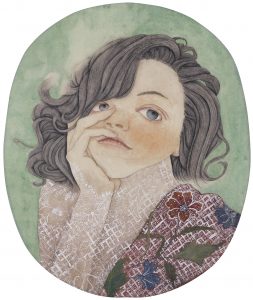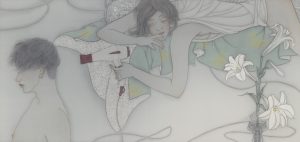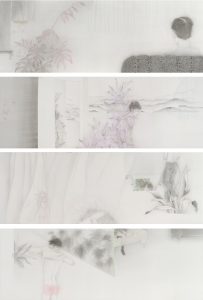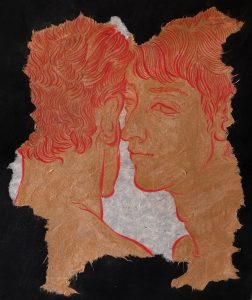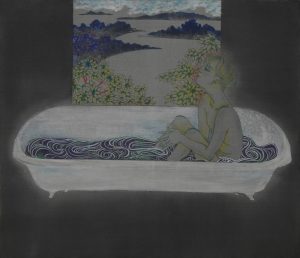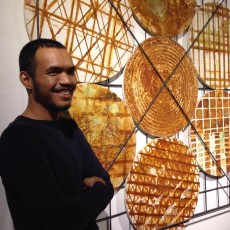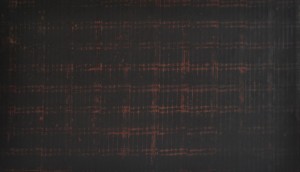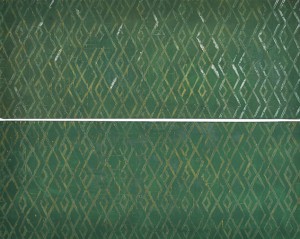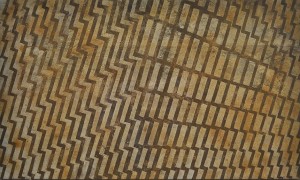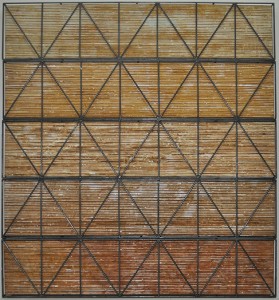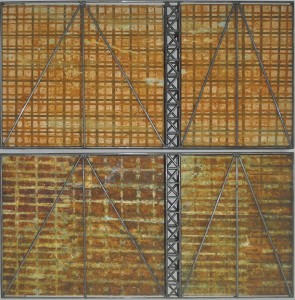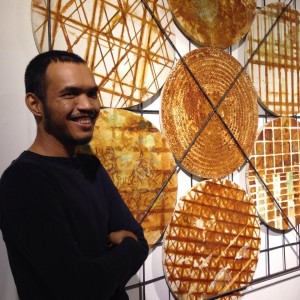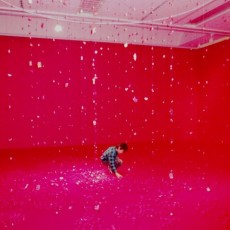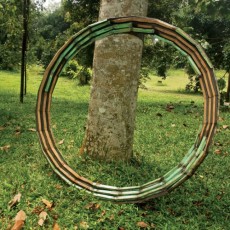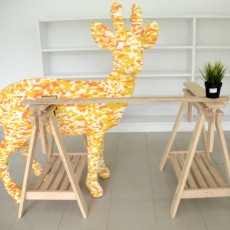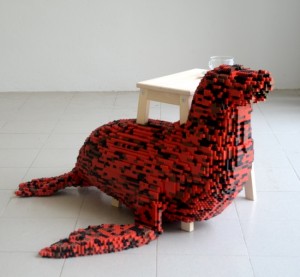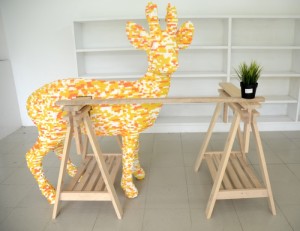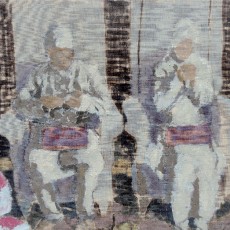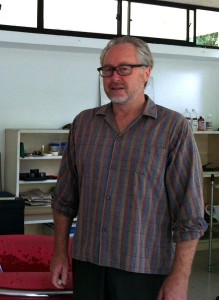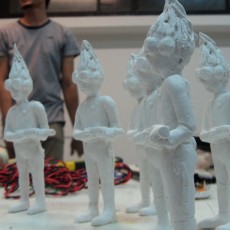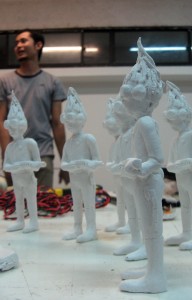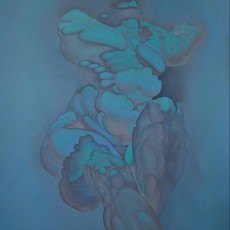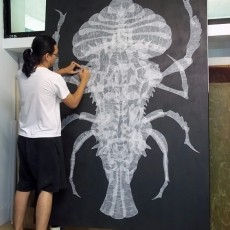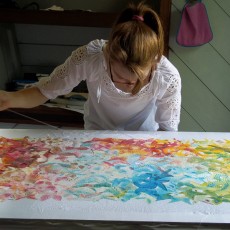Exhibition of Jessica Watson’s Work
Gecko on My Shoulder
The 16th Rimbun Dahan Residency Exhibition
6th to 20th March 2011 in the Underground Gallery at Rimbun Dahan

‘Penang Cloud’, 2010, fabric ink & silk embroidery thread on cotton, 56 x 142 cm.
Acknowledgements: Hijjas Kasturi and Angela Hijjas, my partner Alex, my daughter
Jacqui, my parents Sue and Geoff, Marianne Erikson, and the Swedish Arts Grants Committee.
Textile Art with glowing colours, growing in Jessica B Watson’s concepts
“…Into the future I would like to continue working with costume, sculptural textiles and art as a profession. I’d like to continue developing and exploring – methods and paths may change along the way but I’m sure that something shall glow and grow…”
These were the words Jessica wrote ten years ago, concluding the report of her Masters’ Degree in 2000. Her project then was called “Flickers” — a colourful swarm of mushroom-like figures, entering trams and spreading out in Gothenburg City, Sweden, as homage to spring, blowing into the gloomy infrastructure after a long winter. — What is this? Confused people asked. This playful group in Jessica’s designed outfits also took part in the Gothenburg Dance and Theatre Festival, which led to further engagements in the international field.
Nature seems to influence Jessica wherever she goes in this world: The structure of the squiggly bark of the eucalyptus trees in her native Australia, the bright red mushrooms with white dots in Swedish forests, the vivid yellow lichens of the grey rocks at the Scandinavian coast and here the tropic vegetation of Malaysia. What inspiration do they bring out in an artists’ mind?
Her motifs are, however, not only aesthetic or decorative, they also reveal a concept. That is what makes them soimaginative. They deal with different phases of human relationships. Some phenomena in nature take a long time to grow; sensitive textile art is indeed time-consuming and sincere relationships between people need time to build up. All to be handled with care!
Characteristic for Jessica are bright colours which vibrate through layers of different materials and are accentuated through light and a number of techniques. Embroidered simple lines or sketchy, but dramatic stitches show an expressive movement in her pictures such as the ambulating salesmen with their dangling goods on the beaches of Rio or heavily falling rain where she is now. Motifs are emphasized, being worked in series and different scales. Her three-dimensional forms show connection to wearable art and costume design.
For an observant and aware artist like Jessica the environment of Rimbun Dahan ought to be stimulating. Her residence is in an old traditional Malay house, surrounded by a large garden. The multicultural society, where Muslim arabesques and lattice screens meet ancient Chinese symbols and Indian kolam applications are incorporated in Malaysian daily life. Here the skilled handicraft is the base of a fascinating blend. The blue sky holds changing dragon-clouds, bringing cosmic energy to people on the earth. Look up and you will see!
Jessica’s titles are often subtexts. “Good things happen in threes” is among her recent works. The three fertilefig trees, supported by the screen, are individuals, each carrying an ethnic issue. Delicate embroidered lines, like nerves in a leaf, shape shou — the sign of long life, still beloved by the Chinese. The polychrome segmented leaves are influenced by the colourful Indian kolam floor decorations. The third plant with translucent, fluorescent flowers is like an attractive part of Malaysian songket (weaving with gold or silver thread). It is a piece of beauty, but it also points at some global complications. People from different regions and religions live together and have to face the problems of coping with each other. Hopefully they will grow together, glow side by side, like the art of Jessica. Intentionally she uses a combination of frottage, songket, screen-printing, hand painting and embroidery to achieve a richness more expressive than in a painting. Being open-minded the spiritual fire will be maintained, developed by concentrated work to multifarious flowering.
Marianne Erikson
Textile historian, Head of the Textile collections at the Röhsska
Museum of Arts & Crafts and Design, Gothenburg Sweden
between 1974-1999.

Jessica Watson embroidering ‘Rain Falling on Butterflies’, a work for Art for Nature 2010 ‘SURVIVAL’. Photo by Noor Mahnun Mohamed.
About Jessica Watson
Jessica Watsons’ work is a fusion of 2-dimensional textile art and wearable art. Her interest in the human body, both covering and depicting it, has taken her into the fields of art, costume design and fashion.
Surface, identity and contact are reoccuring themes in her artwork and as a textile artist she subconsciously investigates the boundaries imposed upon textile art from the fine art world. Working predominantly in series, Watson develops and enhances her ideas through repetition and scale.
In 2003 Watson spent three months in the Australian Snowy Mountains where she developed embroidered screenprints based on the squiggly bark eucalyptus for the joint exhibition wouldwork. In 2006 and 2007 she travelled to Rio de Janeiro, Brazil, dividing her time between ritzy Ipanema and the Rio slums developing the embroidered series Sketches from Rio based on the salespeople of Rio de Janeiro’s beaches and the traditional ‘plein-air’ sketch.
Her interest in textiles, the human body, clothing and movement has also led her into costume design where she has worked with childrens productions, musicals and provocative political drama/dance with Swedish, African and Iraqi choreografers.
Watson started her visual art studies at Newcastle University in 1995 and in 1996 travelled to Sweden as an exchange student. In 2000 she graduated with a Masters Degree in Textile Art from Gothenburg University, School for Design and Crafts in Sweden (HDK). Since graduating she has been exhibiting in Australia and internationally.
She has been teaching fashion drawing and screenprinting for the past seven years and is represented at the Gothenburg City Arts Council, in private art collections and has received the Swedish Artists Associations (KRO) One Year Artists Working Grant and the Gothenburg City Arts Grant among other grants and prizes for her work.
The patterns, colours and textures of plants inspire me; enlarging these to create compositions I move the identity of the plant into another context. I have previously worked with cold climate plants and am now interested in looking at the tropical plants of Rimbun Dahan and what they reveal. I aim to continue exploring the themes of identity, surface and contact using the garden plants of Rimbun Dahan and Malaysian butterflies as sources of inspiration.
-

-
Cover of Jessica’s catalogue for Gecko on My Shoulder, featuring Surviving Paradise (detail), 2010, fabric ink, oil pastel, pencil & cotton embroidery thread on cotton, 60 x 140 cm.
-

-
‘Good things happen in threes’, 2010, watercolour & gouache on paper, 21 x 15 cm.
Curriculum Vitae
2000
1998
1996-97
1995-96 |
Education
Master of Fine Arts and Applied Crafts HDK, Göteborgs Universitet
Bachelor of Textiles, HDK, Göteborg Universitet
Undergraduate Student, HDK, Göteborg Universitet
Undergraduate Student, Newcastle University Australia |
2009
2008
2008
2006
2005
2004
2003
2001
2001
2000
2000
2000
2000
1999
1999
1999
1998
1998
1996 |
Exhibitions
Sketches from Rio, Art in Motion, Frank & Ernest
Sketches from Rio, Galleri mitt i centrum, Gothenburg, Sweden
Sketches from Rio, Galleri Mosebacke, Stockholm, Sweden
Broderia Fantasia, Floras Rike Gallery, Botanical Gardens, Gothenburg
Butterfly Stomach & Hunter, Gothenburg City Library
Hunter, Galleri D Lyx, Malmö, Sweden
wouldwork, Knot Gallery, Sydney, Australia
Watt Space, Newcastle, Australia
Omfång, 25m2 Stockholm, Formargruppen Malmö, Galleri 5 Visby
flickers, Gothenburg, Sweden
Talente, Munich, Germany
Omfång, Galleri Koch, Stenungsund, Sweden
Masters Exhibition, Rohsska Museét, Gothenburg, Sweden
Under det blå tacket, Magnus & Magnus, Gothenburg, Sweden
Centrum, Frölunda Kulturhuset, Frölunda, Sweden
HDK 150 år, Rohsska Muséet, Gothenburg
Karin and Carl Larsson, Nordiska Museét, Stockholm, Sweden
Suecos, Centro Cultural La Santa, Barcelona, Spain
Den Lilla Svarta, Rohsska Muséet, Gothenburg |
2006-09
2004-09
2005
2005
2004
2004
2003
2003
2002
2002
2001
2001
2000
2000
2000
2000
2000 |
Employment/Productions
Teaching, Fashion Drawing, Art & Design, Tillskarakademin in Gothenburg, Sweden
Teaching, Fashion drawing, Screen Printing, Art Collage, Folkuniversitetet, Sweden
Downup & updowN, Costume Design & Makeup, Tortosa Theatre Festival, Spain
’Objector’, Bachelor Examination, Borås school of Textiles, Sweden
Screenprinting workshop, Stenebyskolan, Sweden
Costume for the stage, Assistent, Lindköpings University & Vadstena Akademin
Drömmar (Dreams), GöteborgsOperan, Costume Design, Costumer & Makeup
The Lion King, Beading, Anthony Philips Costumes, Sydney, Australia
Howard Katz & Holy Day, Breaking Down, Sydney Theater Company
Downup & updowN, Dance production, Costume Design
Infra Exhibition, Installation, The Gothenburg Museum, Sweden
pillow room, ’Noll Vision’, Trollhättan, Roads and Trafic Authority, Sweden
The Merry Widow, Costume Design & Millinary, Arbisteatern, Norrköping
Gående bord (Walking Table), Dance production, Costume Design, Göteborg
Lethe-The Urban mytoplay, Costume Design, Gothenburg Culture night
flickers, Costume Design & Production Management
flickers, Gothenburg Dance and Theater Festival & Hedens Lustgård Opening Ceremony |
2009
2008
2005
2002
2000
2000
2000
2000
1999
1999
1999
1999
1996 |
Grants
Konstnärsnämnden (Swedish Artists’ Committee) One year Artists’ Working Grant
Företagarna (Association for small businesses in Sweden)
Konstnärsnämnden (Swedish Artists’ Committee)
Gothenburg City Arts Grant
Markarna Lindeqvists Scholarship
Estrid Ericsons Scholarship – group
Slöjdskolans Scholarship
Anna Ahrenbergs Scholarship
Goteborg&Co sponsorship
Stiftelsen Erik och Lily Philipsons Minnesfonds’ Scholarship
Theodor och Hanne Mannheimers fund
Slöjdskolans Scholarship
University of Newcastle Student Exchange Scholarship |
|
2008 |
Represented
Gothenburg City Arts council |
2007
2000
1999
1998
1996 |
Prizes
Golden needle, Täcklebo Embroidery Academy, Sweden, silver needle prize
World Wide Wool, Australia
Near Distance, Lochem, The Netherlands, 2nd prize
Fashion Design Competition, Barcelona, Spain, 1st prize
Hunter Institute of Technology, Mardi Gras Costume Design, 3rd prize |


